Matador Network's Blog, page 2305
February 19, 2014
How to avoid an editor's trash pile

Photo: Neal Sanche
1. Don’t be vague in your opening sentence.
“We soaked up the warm sunlight.” Who? Where? Your reader is immediately irritated and bored.
Do be precise.
“The late morning sunlight melted across the parking lot of the quiet little motel in Yucca Valley, California. My best friend Ev and I took our coffee and sat on the back of the truck.” (More on why this sentence works in #3.)
2. Don’t address your reader directly.
“You’ll love it in Moab, Utah. Bikes, babes, and bars. Check it out, dude.” It was trendy for a while, but not anymore. It makes you sound like a college newspaper columnist. And, these days, it’s likely your slang is going to be out of date before the editor starts to read your piece.
Do keep it simple and in first person.
“I pulled into Moab, Utah just as the sun dropped behind a burnt orange ridgeline. I was headed for a solo trip through Stillwater Canyon on the Green River. My old buddy Chris had told me that Tex’s Riverways was the way to go — and that Eklecticafe had coffee that would rip your heart out.”
3. Don’t use only one sensory system to observe and report.
“The sky over the mountains was bright blue. Ravens flew above our heads. I could see trucks loaded with gear jammed up at the stoplight.”
Do use sound, sight, touch, smell, and taste to draw your reader in.
“Ev and I rolled up our windows. The exhaust reek from the gear-packed trucks idling at the stoplight made the street a deathzone. The roar of a phalanx of motorcycles just behind the trucks was deafening. The middle-aged bikers looked like well-groomed beetles.”
(Note: The example in #1 includes what we saw, heard, felt, and tasted.)
4. Don’t assume your reader is going to be fascinated by your trip to Santa Fe, Telluride, Costa Rica (the list of fashionable places to go is endless) just because you are.
“It was our first morning in Costa Rica. The air was fantastic and the natives really friendly.”
Do (even if you’re writing about a common tourist location) dig deep.
“Ev and I never expected to find a cheap place to camp outside of Telluride. After all, it was the weekend of the Telluride Mushroom Festival in the middle of a sweetly cool August. Ev saw the sign before I did. ‘Park here. $5. Breakfast $5.’ The owner of the little chartreuse house was an old woman in jeans and a flannel shirt.”
5. Don’t forget whatever you learned in basic English composition and DO NOT send in your first draft.
“Standing on the corner of some streets in Prescott, Arizona, my hat flew of my head in a strong wind. irritating.”
My earnest grammar and spell check program raced in to correct this before I could. This sentence would cause any self-respecting editor to not only trash your piece, but to put you on his or her Delete Immediately list. The writer has used passive voice (Yawn) and embellished it with spelling errors, a hat that is irritated, and a sentence fragment.
Do check out any of the good online sources for professional writing.
I like Super Teacher Worksheets and EnglishForEveryone.org. I never send out a piece that I haven’t edited at least five times — and sometimes had a friend look at.
6. Don’t gush.
“Blue Willow is the most charming and unique restaurant in the sun-drenched, up-scale, and fascinating Sunbelt city of Tucson.” Your piece could be a travel brochure, and while Blue Willow is indeed a great place to eat, there are plenty of unique restaurants in Tucson — which is anything but uniformly up-scale.
Do the hard work of writing the details.
“I was so bored with camp grub that I would have eaten fast food. I was spared. My Tucson pal, Shawnee, took us to the Blue Willow, an airy, soft-lit restaurant on Campbell. The first thing I noticed was the scent of spices.”
When you write details, rather than generalizations, the reader is right there with you — at the Blue Willow or anywhere else.
7. Don’t piss on the locals.
“The waiters and waitresses, even the bus drivers in (any little rural town or big city all over the world) seemed surly. I wondered if it was because of the filth in the streets and the fact that there didn’t seem to be an unbroken light bulb in any of the street lamps.”
Whoa, ‘scuse me. You went on your big brave world travels to experience something other than your nice safe world back home. Wherever you go, you are in someone’s home. Write with respect. (I live in a tourist town and have listened to visitors whining about how Flagstaff is not like back home.)
Do write differences without judgment.
“At first glance, the Mojave marine base town of 29 Palms looked like any other faded-out desert village. Ev and I were hungry after a long morning of climbing at Joshua Tree. We checked out the street. There seemed to be nothing but jar heads and their wives taking Saturday off to shop. I pulled next to a young couple and Ev leaned out the window. ‘Where’s a good place to grab breakfast?’ The Marine grinned. ‘Check out Andrea’s.’ He pointed. ‘Best home fries in California.’ We did. They were. Later we discovered not just the perfect dessert — a bag of donuts from Jelly Donut — but fifteen miles down the road in the town of Joshua Tree, Joshua Tree Outfitters, where the owner did an emergency fix on one of the zippers on Ev’s ancient backpack.” [image error]
Author’s note: If you are just beginning to travel write — or have been writing and find yourself blocked — check out the MatadorU Travel Writing program, or my Breakthroughwriting mentoring site.
The post 7 ways to not end up in an editor’s trash appeared first on Matador Network.

On Paris as a cultural wasteland

Photo: Adrien Sifre
If at first it sounds provocative to say that Paris — a city that has played host to the writing flair of Hemingway, the exotic dance of Josephine Baker, the modern choreography of Benjamin Millepied, the painterly genius of Picasso, the philosophizing of Derrida — has become a culturally stagnant city, one must only look at some of the latest facts.
Paris boasts few artists of international recognition, it has a Ministry of Culture that seems to do anything in its bureaucratic power to keep Paris from progressing, and French nationals occupy every notable cultural post. The operagoer no longer heads to the Palais Garnier in the 9th arrondissement, but to Charlottenburg in Berlin or to Covent Garden in London. For literature, there hasn’t been one groundbreaking novel out of France in decades. As far as art, Parisian auction houses are suffering, accounting for only 8% of contemporary global sales, and hardly any contemporary French artists compete on an international scale (Jacque Villeglé is the only living French artist on show at the Museum of Modern Art in New York, and there are only two modern French artworks in London’s Tate Modern). As far as cuisine, classic brasseries still exist, but conglomerates are quickly buying them up. Sushi, hamburgers, and American-style coffeehouses are now the preference of the hippest Parisians.
And, while it’s seen as “cosmopolitan” and “worldly” in other countries to have nationally diverse museum curators, ballet choreographers, art school headmasters, and the like, it would be an outcry against the long-lived tradition of French cultural incest were, say, a Spaniard to take over the Musée d’Orsay. Calling Paris a cultural wasteland sounds harsh, controversial, and provocative. But, cruel as it might be, it is, on the whole, quite true.
I. Funding elitism
For starters, Paris is a city now almost exclusively reserved for the bourgeois. While Mayor Bertrand Delanoë hasn’t pushed rents sky-high quite like former Mayor Michael Bloomberg of New York, Paris is both quite expensive and subtly discriminatory. If you’re looking to apply for a job, you must include a photo on your CV. If you want to rent or buy an apartment, you must provide a dossier. In any case, the final decisions generally help keep Paris homogenized — white, moneyed, and “cultured” in the most bourgeois sense. The cultural ebb and flow has all but receded to Paris’ sounding areas like in Eastern Belleville where galleries like Frac Ile-de-France/Le Plateau (owned by Jocelyn Wolff, a woman who’s been instrumental in mixing eastern Paris cultural palettes with western Paris business savvy) show that the diamonds lie on the roughest edges of the city. Paris proper seems to be slowly atrophying, a muscle that has long ago stopped being able to afford to pick up a pen or paintbrush.
Just as video killed the radio star and gin and tonics killed Fitzgerald, it’s the very cultural policy of Paris that has hurt its culture and bolted the escape door shut. The tightrope between maintaining the “golden era” of Paris and succumbing to modern needs and realities is far too thin, and good ideas have gone tumbling into the abyss.
Like any flushed tourist, the Anglo-American media are all too excited about the (false) cultural history of France.
Following François Mitterrand’s election in 1981, Jack Lang was hired into the new position of Minister of Culture. Immediately, Lang went to work creating new cultural sub-bureaus meant to fund and spur on the great traditions of French creativity, like the Délégation aux Arts Plastiques (Department of Visual Arts), and the Institut National du Patrimoine (National Heritage Institute). The bureaucracy is painfully rigid, and it has only furthered a French-centric viewpoint to any and all creative endeavors coming out of France. With art subsidies comprising about 1.5% of France’s GDP — double Germany’s and triple Britain’s — a surprisingly high-quality life can be had for the French artist who chooses to paint, write, sing, or act. Yet, an artist can only win a subsidy if his/her art is pleasing to France’s elite. That’s to say, this subsidy program deters subversion of the French system or the creation of any sort of unique, revolutionary art.
It’s certainly in vogue to complain about the Americanization and subsequent cultural death of France. The American magazine Time published an article called “The Death of French Culture,” and The Economist, a neo-conservative British weekly, is constantly bashing the French, even devoting a recent issue to a 14-page report on the decline of France’s economy and culture entitled “The Time-Bomb at the Heart of Europe.” Where are these complaints exactly coming from? Well, in France’s defense, there’s a misunderstanding about what French culture used to be.
Like any flushed tourist, the Anglo-American media are all too excited about the (false) cultural history of France, and thus depressed when they realize today’s French culture doesn’t quite live up. The truth is, though, the dynamism of France’s cultural history has always been overplayed, fetishized by foreigners who, feeling repressed in their own countries, are looking for a cultural Mecca somewhere else.
As means to compensate for these grandiose expectations, perhaps French bureaucrats have gone too far.
Any sort of cultural egalitarianism — of funding non-French cultural pursuits — is inherently threatening to the elite class, which makes it all but impossible for it to get a political foothold. And yet, if France is to regain its cultural superiority — not to mention live up to the second tenant of liberté, égalité, fraternité — money will have to be funneled to artists who hail from Maghreb to England to India, to creators who didn’t spend their time at the École nationale supérieure des Beaux-Arts, but spent it working outside city limits. Whether or not outsiders will deride this kind of diversity as “a loss of French culture” is their own foolery, and not the problem of the French.
II. An imagined history
Like most powerful, developed countries, France has a history of oppression, ranging from Nazi collaboration to colonialism; yet they’ve chosen to deal with it by not dealing with it. While Germany, for instance, took a variety of measures to ensure its dark history wouldn’t be repeatable — from declaring it illegal to deny the Holocaust to issuing a multitude of public apologies for their tragic past — the French have taken the approach of not discussing the dark moments of their history at all. When something is off-putting, it is simply not discussed. It’s the same tactic the French use for discussion of race, Algerian colonialism, the Vichy regime, and the protests of May 1968. So, when politicians do try to discuss France’s less-than-perfect past, the apologies invariably come off as more than a little odd.
Paris has erased the dark corners of its history through its museums, architecture, city planning, and monuments.
For example, in May 2007, on the 50th anniversary of the riots of May 1968, and a year before he would run for the French presidency, Nicolas Sarkozy said it was finally time to erase any remaining vestiges of the “most unfortunate occurrence.” That’s to say, rather than dealing with the landmark historical event that began the division of the bourgeois from the common class in the 20th century, Sarkozy proposed that the French should simply use the magic eraser of political rhetoric to do away with France’s past tragedies.
Exhibiting a specific history is a way to deal with the past. The French have done this with their capital city, putting Paris “on show” so to speak. While Venice, for instance, cherishes its labyrinthine waterways and Byzantine bridges as a way to point to its Renaissance past, Paris has erased the dark corners of its history — whether its cooperation with the Vichy regime or colonialism that ceased only recently — through its museums, architecture, city planning, and monuments. In doing so, Paris has altered its past.
Most notably, the Musée Carnavalet, which bills itself as a comprehensive “museum of Paris history” and sits centrally in Paris’ Jewish quarter, never makes reference to the Shoah or the anti-Semitic atrocities that occurred during the Second World War. So too grand avenues lead to monuments showing France’s great might — like the Arc de Triomphe — but nowhere does the city represent its past entirely accurately, for instance with a statue not of war power but of the tragic violence of colonialism. Even the Musée de l’histoire de l’immigration, the museum of immigration history, conveys a rosy vision of immigration, where each person who comes to France will be accepted so long as they work hard and try to assimilate. Indeed, this is not the case.
III. An (understandable) lack of action
There is a certain awareness of what Paris is “supposed to be,” and if something seems non-conformist it tends to be rejected by France’s current conservative cultural policies.
Take the city’s architecture, for instance. The Haussmannian structure is still the dominant vision on the streets of Paris. Save for the Marais and a few tiny neighborhoods, Paris is one staid sea of sandstone facades and wide avenues. It’s being kept that way too thanks to strict regulations on new buildings, which are required to fit in with the buildings surrounding it. Not that this is necessarily a bad thing. This “unified” urban space makes for postcard-friendly photos and gives Paris a sort of personality — an impossible feat in an intentionally fractured city like New York.
And yet, so much talent and potential beauty is being wasted. The best French architects like Bernard Tschumi and Jean Nouvel are forced to use their beautiful craft in cities like London and Berlin, where architecture regulations on private residences are significantly more lax than in Paris. Should the French government allow their cities to progress in style, or should they keep it just the way tourists want to see it? From a fiscal standpoint, that’s a no-brainer.
For all of Delanoë’s progressivism, Paris’ beloved mayor hasn’t done much to turn around Paris’ stale culture. Why not allow for new styles of architecture? (Likewise, what would be so wrong about funding writers and painters who want to express the complexities of colonialism or the trouble with French bureaucracy?) As one could rather easily guess, the answer is in the numbers.
It’s a shame to see how significantly money influences culture, even if it is not all that surprising.
France averages 78 million tourists a year — more than any other country — and the vast majority travel through Paris. Although Fontainebleau is the top tourist destination in France, the Paris-based Notre Dame, Centre Pompidou, Tour Eiffel, and Musée du Louvre see the third, sixth, seventh, and eighth most tourists in France, respectively. Given the fact that France is never at a lack for tourism revenue, it would not make much sense to pour money into independent galleries, new shops, and individual cultural pursuits when, from an economic perspective, nothing is broke — so why fix it? Instead, Delanoë has leveraged what he already has for more (a lot more), such as recently inking a $1 billion deal to allow the United Arab Emirates to not only open a new “Middle East Louvre,” but also to ransack some of the Paris museum’s key chef-d’oeuvres to be shipped off to the Abu Dhabi-based museum.
Given the fiscal aspects of French culture, the greatest problem facing Paris’ culture today is that its worshippers are the consumers (the tourists), not the creators (the artists). Consumers flock to Paris to see the “Mona Lisa” and experience the gardens of Versailles, but how many foreign creators can afford to stick around the capital? And, given the government’s strong preference to French artists, how many would even want to?
It’s a shame to see how significantly money influences culture, even if it is not all that surprising. The fact that targeted subsidies make it all but impossible for non-French artists or artists who don’t have a great interest in supporting the Fifth Republic to make a living is one thing. But it’s another thing when these policies are so clearly hurting Paris — turning it into a city that can be photographed nicely and quickly consumed, but one that has nothing new to stand on. France has lots going for it, and it’s doubtlessly one of the greatest countries in the world.
Yet, as far as its famed culture, changes need to be made. The days of Pissarro’s paintings of the Tuileries and Balzac’s Paris-set novels are over. French culture simply means exciting art happening in France. It means France being recognized for what it could and should once again be: a place of artistic retreat, of inspiration, of creativity. While many French artists are still seen as some of the best in the world, it’s simply too easy for France to rest on the laurels of its storied history. In the coming years, without change, I fear they will have nothing to stand on at all.
IV. The decline of all cultures
And yet, it’s important to realize that while one might point out France’s cultural stagnancy, it’s an affliction suffered by all world powers. There’s always the up-and-up, where the once weak country becomes a major global contributor to the economy, to the balance of power, to art and creativity. But as quickly as this power comes, it invariably fades away. What is American culture now anyway? Is it hot dogs, baseball, and diabetes, as so many other countries might believe? What is modern British culture? Is it big breakfasts, pubs, and boarding schools where elites are easily reproduced? What is Italian or Spanish or Portuguese or Swiss culture for that matter? Perhaps anti-Frenchness and the assumptions of France’s cultural demise are rooted predominately in the insecurities of other Western countries.
Perhaps the Anglo-American view of France is really just a mirror to our own loss of vitality, our own fears of Chinese power, of other countries coming onto the scene, ready to steal our lines. Perhaps by pointing out the flaws in a former world power, we are trying to insulate ourselves from our own eventual decline. Or perhaps, the City of Light has gone dim, and with all its beautiful museums, it has finally become one itself. [image error]
The post How Paris has become a cultural wasteland appeared first on Matador Network.

Global Sunrise Project kicks off

At the 57th Commission on the Status of Women. Photo: author
I’m Kasha and I’m 15 years old. I’ve been interested in social justice since I was 8. As I’ve grown up, I’ve been learning about serious issues facing our world in a variety of settings — classrooms, textbooks, public presentations, through media and online — but I’ve never had the opportunity learn about many of them in the most important way, which is first-hand.
Last year I got that chance with my very first trip abroad, to Cuba. I wasn’t quite sure what to expect. I arrived late at night and as I peered out the bus window, even with the little I was able to see, I got a sense that Cuba was very different than what I was used to. As much as I enjoyed my winter break off school and hanging out at the beach, I was more interested in exploring life outside of the resort in the surrounding cities as much as we could. There I got to see people in their natural environments and it was a culture shock for me to see the extremely different way of life compared to the one back home.
Shortly after I returned from Cuba I had the opportunity to go to the UN as a youth delegate at the 57th Commission on the Status of Women. I met many people who gathered at this conference from all over the world. This got me one step closer to knowing more about the world and the issues I cared about but I still hadn’t experienced their world first hand.
I returned from the UN and saw an online contest with GAdventures to pitch an idea that would change the world. I entered my idea Picture the Power of People with A Purpose; (This is where The Global Sunrise Project really got its beginning.) I didn’t make it as one of the finalists, but I came really close and my mom was open to exploring the idea of how I could turn this into a reality. That’s when this huge gathering of travel bloggers and writers (TBEX) rolled into town and my mom and I decided to see check it out. I was so happy because that’s where I met Lola Akinmade Akerstrom who would soon become my photography mentor on the project.
So, what is The Global Sunrise Project? It’s an exploration of what it means to be a global citizen. In March, 2014, I will be travelling with my mom. Our first stop will be the United Nations to attend the 58th Commission on the Status of Women and then hopefully we’ll be off to South America, Africa, and South East Asia where I will film inspirational stories of hope and resilience of people I meet along the way. I want to document the beauty of people and places and show why we need to care more, connect more. I find it important to travel now because the experience could really help shape my path beyond high school. I hope you’ll join me online for that journey.
To support this project, Please visit our website, make a donation if you feel inspired, and help by spreading the word. [image error]
Visit our website, Twitter, Instagram, and Facebook.
The post 15-year-old Kasha Slavner looking to make world of difference with Global Sunrise Project appeared first on Matador Network.

BREAKING: Chilling livestream footage of the riots in Kiev, Ukraine
THERE IS SOMETHING so haunting about watching a city square engulfed in flames, while a church service is broadcast in the background – that’s what I heard while watching this livestream of the riots currently going on in the Ukraine, this afternoon at about 11:30am EST. I can’t even imagine what it’s like to be in Kiev right now, but I am thinking about everyone involved, and their safety.
Matador ran a photo essay by photo journalist Ilya Varlamov back in January; click through to read more about the political unrest in this area of the world, as well as to see his incredible ground-level footage of the action. Whether or not you agree with the cause, this is important to watch. 
Live streaming video by Ustream
The post BREAKING: Chilling livestream footage of the riots in Kiev, Ukraine appeared first on Matador Network.

How to piss off a feminist

Photo: Melissa Brewer
With all kinds of strong women in the news (Hillary 2016!), feminism has come a long way. In the past couple of years alone, things from feminist digital campaigns to an increase in anti-harassment policies at conferences have made women feel safer and stronger about speaking out. And yet, as if the patriarchy wasn’t enough to be mad about already — I’m still making 78 cents on your dollar, white men! — here’s a list of things that can infuriate anyone interested in equal rights and reducing sexism.
Please note: None of these things are done exclusively by men towards women; sometimes other people do them to women too. Also, I believe anyone can be a feminist. Feminism just means believing that the current system is not very equal and tends to minimize the lives of women (and “girly” men, under the assumption that acting like a lady is bad). If you believe this, you are a feminist. No matter what your sex or gender. (Some people believe men calling themselves “feminists” is another co-opting of women’s space, so please be aware that you might get negative reactions from some feminists if you identify as male and call yourself a feminist.)
Use the word “Feminazi.”
Yes, because equating people who are interested in overthrowing a male-dominated global standard, to the benefit of men, women, and everyone in between, with the perpetrators of a heinous genocide makes SO much sense. Feminazi is a way to belittle women for speaking up too loudly — you don’t want to be one of those strident irritating feminists that talks too much, do you? Yes, actually. I do.
“It’s just a joke! God!”
Ha ha ha, yes, I certainly feel a sweeping sense of relief that you clarified your statement about me getting to the kitchen to make you a sandwich was a joke. I wasn’t laughing because it wasn’t funny. Not because I have no sense of humour.
Sexist jokes, just like racist jokes, are based on belittling and debasing a minority group…which, hey, I thought was classified as hate speech! So, ha ha, thank you for identifying yourself as someone who will engage in hate speech for the sake of making someone laugh. I will make sure to stay very far away from you in the future.
Be a Nice Guy™.
A trope that has now become popular enough to have several websites dedicated to calling them out, Nice Guys™ are those guys who don’t ask a girl out for ages, preferring instead to masquerade as an actual friend, then react negatively when she says she’s uninterested…unlike actual guys who are nice, who would value a woman’s company even if she wasn’t putting out.
“That bitch turned me down!” they might shout. “Women only ever like assholes, but I’m such a nice guy they never go for me!” Easily identified by their fedoras, entitlement to women’s bodies, and frequent use of the word “friendzoned.”
Mansplain.
This helpful portmanteau describes those situations where a man speaks to a woman with an assumption that she knows less about the topic being discussed than he does, just by virtue of her being a woman. Whether conscious or not — and many mansplainers are not even aware of their inherent assumptions…that women can’t know anything about sports, for example — this is intensely irritating.
I once checked the oil in my car and went into a gas station to buy some more; the guy behind the counter looked at me accusingly and said, “What do you need that for?” To put on my toast? “I was going to put it in the car,” I said. He started to shrug into his coat. “You’d better let me do it,” he said. “Women don’t know how to check oil. Are you sure you looked in the right place?”
“Feminism is over! We fixed things!”
Oh, I’m so relieved! I’m so glad that feminism succeeded, so we have lots of women in Congress to help pass bills that are about things women want (you know, like control over our own bodies)…oh, wait. And definitely lots of female CEOs and heads of industry, to protect the rights of female sweatshop workers and ensure that the most powerful corporations in the world are not run exclusively by men…hmm. And newspaper magnates and television producers, so we can see positive images of women in the media…oh. Well, I’m sure glad things are fixed.
Slut-shame.
However a woman wants to dress? Is okay. She’s not doing it for you. Or even if she is, that’s okay too. But calling someone a “slut” or a “whore” because they’re wearing revealing clothing both negates women’s expression of their own sexuality and shames women who work in the sex industry. There’s no need to do either of these things, thank you very much.
Slut shaming contributes to rape culture, which is an atmosphere where harassment and violence towards women are the victim’s fault and not her attacker’s. This has terrible consequences for everybody, including making it difficult for men to speak out about being victims of sexual assault, if you can’t figure out why you should care about something unless it also happens to men.
Fat-shame, or otherwise body-police.
Everybody’s body and the way they look belongs to them, and has as much to do with you as their sexual orientation (hint: nothing). Making “helpful” comments about someone’s weight, the way they look in a bikini, or the way they do their hair is just another way to tell them that whatever they look like is not okay.
There’s no need to ask someone if they’ve “just considered going to the gym and eating less.” That’s incredibly rude. Women are bombarded with messages all day, every day, and even in their sleep about how they’re supposed to look and what they’re supposed to do…nobody needs extra reiteration of that. [image error]
The post How to piss off a feminist appeared first on Matador Network.

45 beautiful abandoned places [pics]
Maybe you, like me, are fascinated by the entropy of humanity’s impact on the earth: trees growing up through pavement, deserted mineshafts reclaimed by nesting birds, and ghost towns in the middle of the desert. Something about the sheer perseverence of nature is gorgeous to me.
As you can see from these pictures of abandoned places, I’m not the only one who thinks so. These photos are proof that a place doesn’t have to be full of bustling people to be the most stunning thing you’ve ever seen.

1
Pripyat, Ukraine
The Ukrainian town of Pripyat is approximately 100km from Kiev and right next to the nuclear plant of Chernobyl. In 1986, the reactor blew and forced the evacuation of the entire town of more than 28,000 people. While nothing is allowed to be taken in or out of Pripyat for fear of contamination, photographers still make their way in.
(via)

2
Tunnel of Love, Ukraine
This three-kilometer stretch of private railway hosts a train that brings wood to a nearby fibreboard factory three times a day. The rest of the time, the lush tunnel is full of people out for a stroll. Supposedly, couples who visit the tunnel are granted a wish as long as their love is true.
(via)

3
Seattle Underground, Seattle, USA
When 31 blocks of the city were destroyed in the Great Seattle Fire of 1889, the city was rebuilt one to two stories higher than the original street grade, leaving a subterranean warren of ruined shops, streets, and pathways.
(via)
Intermission

75 places so colorful it’s hard to believe they’re real [pics]

18 scenic places to teach ESL abroad
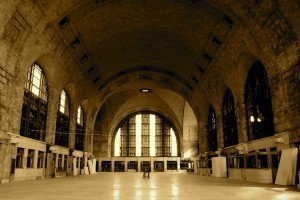
Abandoned train and subway stations of the world [PICs]

4
The Penn Hills Resort, Poconos, USA
This hotel was a popular honeymoon and romantic vacation destination in the 1960s, with its 100 rooms and 500 acres of beautiful Pennsylvanian countryside. In 2009, the owner died at age 102 and the resort closed 2 months later, owing over $1 million in back taxes. It remains unsold and abandoned.
(via)

5
Phone booth graveyard, New York, USA
It's not just places that get abandoned. With the advent of cell phones, New York City ripped out hundreds of phone booths and stored them in an eerie graveyard under some elevated railroad tracks. With no plans to destroy them, presumably the piles of booths will remain where they are until stripped for metal parts.
(via)

6
Olympic Village, Berlin, Germany
The 1936 Summer Olympics, commonly called the "Nazi Olympics," were filmed by Hitler's favorite documentarian, Leni Riefenstahl, to make her controversial film Olympia. After World War II, the village was occupied by the Soviet Army, who used it as a torture base. It has been abandoned since the fall of communism in Germany.
(via)

7
Nara Dreamland, Japan
Inspired by Disneyland, Nara Dreamland opened in 1955 with an almost sarcastically Americana theme that had fountains with statues of Abraham Lincoln and Napoleon. Always underattended, the park closed its doors in 2006 and remains abandoned and untouched to this day.
(via)

8
Maunsell Forts, Thames Estuary, England
These small fortified forts were erected in estuaries of the Thames to protect England against attack from Nazi Germany. After they were decommissioned, several were destroyed by ships running into them, and some were used as pirate radio stations in the 1960s. Paddy Roy Bates claimed Roughs Tower in 1964 and developed the Principality of Sealand, but the other towers remain unoccupied.
(via)

9
Villa di Vecchi, Lake Como, Italy
This fantastically luxurious dream mansion was quickly tainted with misfortune when the count who commissioned it killed himself before its completion, after discovering that his wife had been murdered and mutilated and his daughter was missing. The mansion has been abandoned since the 1940s.
(via)
Intermission

41 places so rad you have to stop driving and get out of the car [PICs]

Pompey’s Pillar to St. Mary’s Peak – 1062 images in 2 minutes

Celebrating the sunsets of Seattle
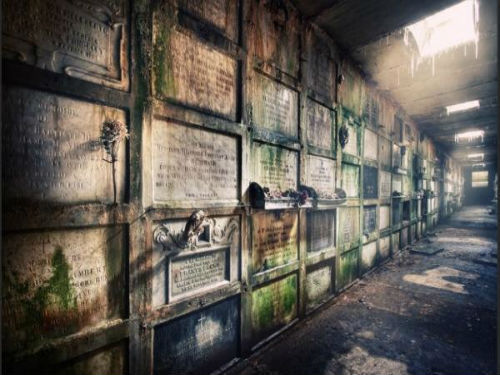
10
La Crypte des Fleurs (pseudonym), Brussels, Belgium
This crypt is made up of three connecting tunnels buried beneath a small chapel in a cemetery in Belgium. The dates of death range from 1885-1978, and the tombs have been apparently untouched for decades.
(via)

11
Power Plant IM, Belgium
This plant in Charleroi, Belgium is said to have begun around the 1930s and was coal-operated. It ceased production in 2006 and is currently set for demolition and overrun with metal thieves.
(via)

12
Berkyn Manor, England
John Milton once lived in this decayed manor, which locals say may be haunted. It has fallen completely into disrepair since its desertion in 1987, and interior stairs, floors, and parts of the roof have collapsed. Trespassers are likely to be arrested if caught.
(via)

13
Buzludzha Monument, Bulgaria
This bizarre flying saucer-shaped monument was built in 1981 to commemmorate secret socialist meetings that were the forerunner to the Bulgarian Communist Party. It is no longer maintained by the government and has been abandoned since 1989.
(via)

14
Eastern State Penitentiary, Philadelphia, USA
Called "the world's first penitentiary," this prison was designed to force criminals closer to God through torture, months in solitary confinement, and enclosure in bitterly cold cellblocks. It closed in 1971 but has been open for tours since 1994. The grounds of the prison contain over 30 different tunnels dug by inmates trying to escape.
(via)

15
Croix Rouge Subway Station, Paris, France
Service to this station stopped in 1939 as preparations for World War II got underway, and never restarted. Passengers can still glimpse the station as they pass through on metro line 10.
(via)
Intermission

Citylapse: New York City and San Diego
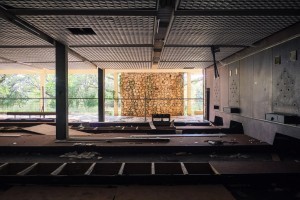
Inside the abandoned palace of Penthouse Magazine in Croatia

24 exceptional ice sculptures

16
Kalavantin Durg, India
According to legend, this fort was built around the time of Buddha for a queen named Kalavantin, but nobody really knows for sure. The steps leading up to the fort (which sits at 2000ft elevation) were cut into the rock of the hill. You can see Mumbai from the fort itself.
(via)

17
Muromtzevo Mansion, Muromtzevo, Russia
This elaborate 80-room mansion took 5 years to build, completed in 1889. After the Russian Revolution, its owner donated it to the state to avoid it being looted. It eventually became the Forest College, then was completely abandoned in 1977.
(via)

18
Berliner Bunkerwelten, Berlin, Germany
During the Second World War, the ground under the city of Berlin became rife with more than 1,000 secret bunkers and tunnels. Connected to the surface only with small ventilation shafts, the bunkers eventually fell into disrepair and filled in...there are now only 100 or so, all privately owned.
(via)

19
Noisy Castle, Belgium
Also known as the Miranda Castle, this summer residence for a wealthy Belgian family was seized by Nazis and later converted into a home for children. Left empty since 1991, the castle is full of beautiful architectural details and old furniture.
(via)

20
Moynaq, Uzbekistan
Moynaq used to be a port town, until Soviet irrigation projects drained the Aral Sea's tributaries and left it 150km from the nearest water. The seabed was further polluted with runoff from the cotton industry, which killed many residents. The town is now inhabited only by a few Karakalpak people, who have populated the region for a thousand years.
(via)
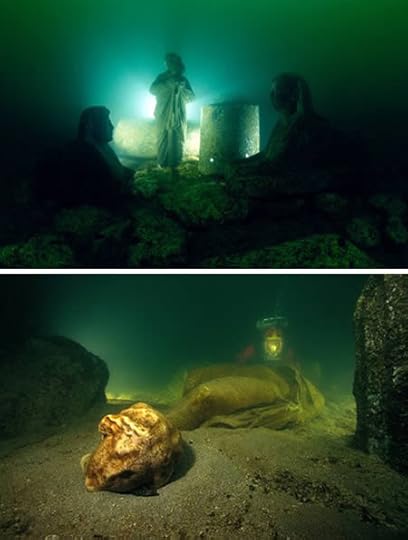
21
Cleopatra's Palace, Alexandria, Egypt
A team of marine archaeologists discovered what they believe to be the ruins of the palace of Egypt's most famous queen in 1996. The royal palace was said to have been submerged by a series of cataclysmic earthquakes and tsunamis more than 1600 years ago.
(via)

22
Strip Club, Okayama Mountains, Japan
This abandoned Japanese strip club was euphemistically labelled a "sightseeing theatre." Strip clubs, onsen, and brothels in Japan are often either not open to foreigners or not easy to find unless you speak and read Japanese.
(via)

23
Skellig Michael, Ireland
A Unesco World Heritage Site, the remote island monastery has been abandoned since the 12th century, when the monks relocated to the mainland. The island was inhabited for 600 years, and is home to a number of beehive huts, two oratories, a church, stone terraces, and meters of stone steps.
(via)

24
Abandoned apartment, Paris, France
Madame de Florian fled Paris in World War II, but left her apartment completely intact, and continued paying the rent on it for 70 years. After her death, an auctioneer entered the space and found an eerie collection of hairbrushes, gilt furniture, taxidermy, and a painting that eventually sold for 2.1 million euros.
(via)
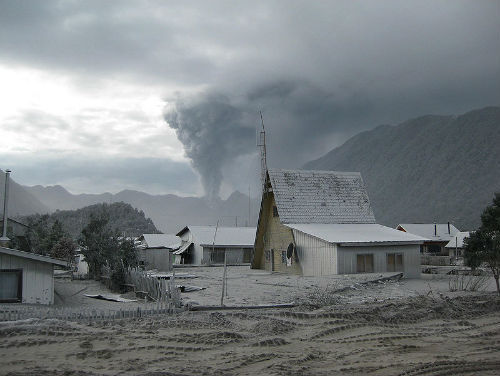
25
Chaiten, Chile
In 2008, the Chaiten Volcano in Northern Patagonia erupted after being dormant for 9,000 years. A volcanic lahar caused a nearby river to divert its course, and the town at the volcano's base was destroyed. In 2011, the president of Chile announced plans to rebuild on the original location.
(via)
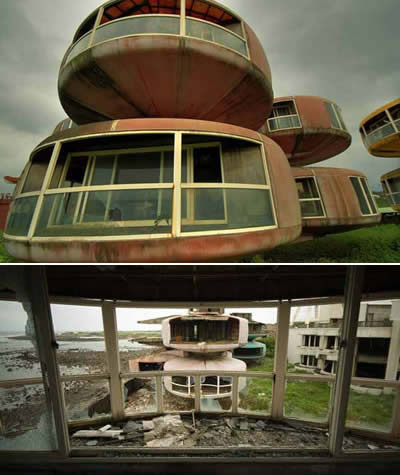
26
San Zhi, Taiwan
This futuristic pod village was supposed to be a resort for the rich, but construction was halted before completion after numerous fatal accidents led to reports the site was haunted. There are no named architects to the project and the government of Taiwan, who originally commissioned the project, have disavowed all knowledge of it.
(via)

27
MS World Discoverer, Roderick Bay, Nggela Islands
This cruise ship was built in 1974 specifically for polar voyages, and had a double-hulled construction to protect it against collisions with ice. In 2000, however, the ship hit an uncharted rock in the Solomon Islands and all passengers had to be evacuated. The captain then steered it into Roderick Bay, where it has remained grounded ever since.
(via)

28
Buffalo Central Terminal, Buffalo, NY, USA
This 17-story art deco building was Buffalo's main railway terminal for 50 years, finally closing in 1979. After it closed, it was extensively looted and vandalized, and some said the only thing blocking it from demolition was the cost. In 1997, the Central Terminal Restoration Corporation purchased the derelict building for $1 and is currently restoring it.
(via)
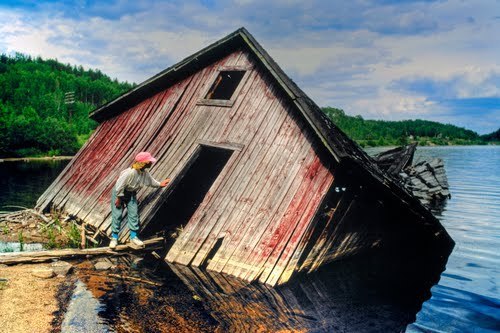
29
Nicholson, Ontario, Canada
300km north of Sault Ste Marie, this tiny Ontario town is only accessible by boat or on foot over the railroad tracks, a 2.5-hour walk. A deserted lumber town, it displays old logging equipment, and many well-preserved abandoned buildings, including a church and a school.
(via)

30
Spinalonga Island, Greece
From 1903 to 1957, Spinalonga was used as a leper colony, and was one of the last leper colonies in Europe. The last inhabitant of the island was a priest determined to uphold a tradition of the Greek Orthodox Church where buried people must be commemorated at 5-year intervals; he finally left in 1962.
(via)
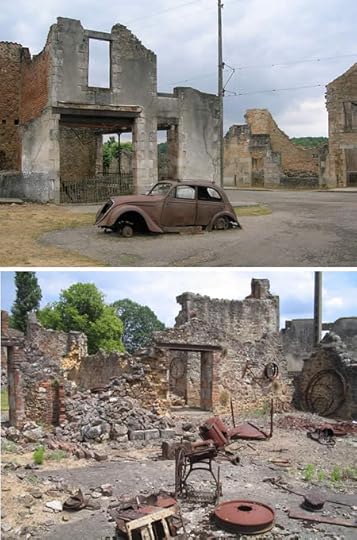
31
Oradour-sur-Glane, France
During World War II, German soldiers mistakenly invaded this small French town, intending to target nearby Oradour-sur-Vayres. 642 of the village's residents were massacred in punishment for the French Resistance, and the village was razed by the Germans. It has stood empty since then, and acts as a memorial to the dead.
(via)

32
Salton Sea Beach, California, USA
Salton Sea Beach was flooded in 1973 by highly saline water from the nearby Salton Sea, an accidental inland ocean created when the Colorado River poured through salt flats in 1905. Residents left most of their belongings and moved elsewhere; you can still find alarm clocks, dolls, and LPs embedded in the inches-thick crust of salt that covers every surface.
(via)

33
Talisay Mansion, Talisay City, Philippines
This enormous mansion in Talisay City, Philippines was built by a sugar baron in honor of his 11th wife. In World War II, Filipino guerillas employed by the US Armed Forces set the building on fire. It burned for several days and sat empty for a long time, until it was remade into a restaurant.
(via)

34
Pyramid of Tirana, Tirana, Albania
This bizarre pyramid was built as a monument to an Albanian leader who kept Stalin's dreams alive long after the Russian dictator died. As national attitudes shifted, the space converted to a convention centre in 1991, then to a military staging centre, then a television station. It has since been looted for building materials and covered in graffiti, and the government is campaigning for its demolition.
(via)

35
Onverwacht, Suriname
This abandoned station was built to transport gold miners into and out of the interior of Suriname. The line went out of use in the 1980s and the train cars were left to decay.
()

36
South Fremantle Power Station, Fremantle, Australia
The South Fremantle Power Station opened in 1951 and employed 250 people at its peak. After technological advances made it uneconomical, it closed in 1985 and has since become a museum of constantly changing graffiti, broken glass, and old spray paint cans.
(via)

37
Whittingham Asylum, Lancashire, England
Whittingham Asylum was once the largest mental institution in Britain; founded in 1869, it had its own farms, telephone exchange, post office, orchestra, and even a brewery. After being taken over by the military during World War II, the asylum slowly declined and finally closed in 1995 after allegations of abuse against patients.
(via)
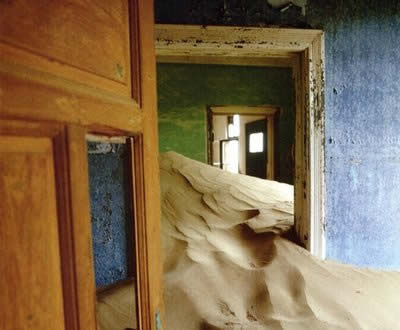
38
Kolmanskop, Namibia
In 1908, the port of Lueditz was inundated with people rushing into the Namib Desert to make a fortune on diamonds. The town of Kolmanskop enjoyed a boom until the drop in diamond sales after World War I, and the town was deserted in the 1950s...to be reclaimed by the desert.
(via)

39
Slab City, CA
Only a short drive from Salton Sea Beach, Slab City sits outside Niland in a remote area of the California desert. Once a World War II Marine barracks, the camp was abandoned, then razed, leaving only concrete slabs. Currently it is used by snowbirds, drifters, and off-the-grid enthusiasts as a temporary city and gathering place.
(via)

40
Michigan Central Station, Detroit, USA
Detroit is notorious for being half-abandoned, half-revitalised. While some sections of the city are deserted, full of condemned buildings and collapsing schoolhouses, other parts are slowly revitalising as current residents repair their homes and new residents are offered free houses.
(via)

41
Tillamook Rock Lighthouse, Oregon Coast, USA
This lighthouse was officially lit in 1881 and quickly nicknamed Terrible Tilly due to the hazardous commute lighthouse keepers faced from the mainland. It was damaged extensively by storms and eventually decommissioned in the 1950s. It is now privately owned and accessible only by helicopter.
(via)

42
Stella Artois Brewery, Leuven, Belgium
This particular brewery was replaced by a newer and more efficient facility nearby. Looters stripped much of the copper and metal fixtures, which led to all entrances being sealed. Stella Artois remains a popular pilsner.
(

43
Moonhole, Bequia, Grenadines
Bequia is full of stone holiday homes that can be rented, but the Moonhole, so called because the setting moon shines through the rock formation archway, is not up for grabs. The danger of falling rocks from above has made it uninhabitable, and it is currently closed to entry.
(via)

44
Harperbury Hospital, Hertfordshire, England
(via)

45
Craco, Italy
The summit where Comune di Craco sits may have been inhabited as early as the 8th century. By the mid-1950s, seismic activity put the town in danger, and a series of landslides forced the entire population to relocate in 1963. It has since been
The post 45 eerily beautiful abandoned places [pics] appeared first on Matador Network.

February 18, 2014
The gentrification of Old Tbilisi

All photos: Author
Tourism is big business. Big enough to change culture itself. Where there is a buck to be made, it will be made — as fast and as efficiently as possible. The architects of the capitalist world we live in are unstoppable, and cashed-up tourists are soft targets in this game.
And so, Old Tbilisi, the historic quarter at the very heart of the modern capital city of Georgia, is being changed beyond recognition. Transforming from a beautifully decaying authenticity, Old Tbilisi is becoming a shiny and hollow scintillation, filled with ever more opportunities to load up on cheap souvenirs and imported beer. Is this the birth of yet another tourist trap?
Old Tbilisi is a centrally located neighbourhood, containing an assorted mix of buildings from as early as the 5th century. Today, the bulk of the structures are an eclectic collection from the 1800s. Much like the nation of Georgia, the area has seen a long and at times tumultuous history. As a result of earthquakes, invasions, and a geographical location within the cradle of various historical empires, Old Tbilisi is completely unique — a diverse, centuries-old urban layering, holding extreme importance to the nation. Worldwide, the priority of preserving the district has been recognised by many independent international bodies. However, over the last decade or so, its future has been in grave danger.

Typical street scene in Old Tbilisi, Georgia.

Eclectic architecture and palette of Old Tbilisi homes.

Doorway, Old Tbilisi house.

Decaying church in Old Tbilisi. Internally, the structure was braced with steel girders, and was too dangerous to enter.

Around every corner, decay. Old Tbilisi.

Irresistible to tourists, for now. Old Tbilisi.

Crumbling facade, typical of Old Tbilisi.

Streets of Old Tbilisi.

Going, going, gone. Old Tbilisi.
There are complex issues to consider in Old Tbilisi — not the least of which are the slum-like conditions that many residents here live with. Many of the structures are now uninhabitable and beyond repair. Despite the obvious bewitching appeal of the streets, Old Tbilisi could be holistically described as both “enchanting, and dismal.” It would appear wrong to be so nostalgically driven as to state that nothing should change in Old Tbilisi. But it’s important to remember that these neighbourhoods are special, unique, and, unfortunately, endangered. In an ideal world, Old Tbilisi is a neighbourhood that retains its authenticity as well as quality of life for its residents.
Currently, older buildings are being replaced with architectural innovations in steel and glass. Disney-esque facadism is taking over — with Irish bars and “authentic” Soviet-themed restaurants housed in restored buildings that maintain little of the original charm. And no doubt, Old Tbilisi will be promoted by the local government as a tourism success story. A new and authentic neighbourhood narrative will be manufactured. Residents will be relocated. Corner stores will be replaced with souvenir shops. International franchises will move in. “Boutique Tbilisi hotels” will become an increasingly popular Google search keyword. Developers and entrepreneurs will be happy. The gentrified grand scheme will be complete, and it will be on to the next target. Viva, capitalism.
I was told that I needed to get to Georgia before it changed. It’s something you get told a lot in the travel world. But in the case of Tbilisi’s old town, it’s judicious advice. In 2013, only small pockets of the “original” old town remain. These unprofitable enclaves will soon cease to exist within Old Tbilisi, as the value of the location is unlocked. But, for now, the twisted back streets filled with gracious decaying buildings are, in my opinion, the number one tourist attraction in town. [image error]
This post was originally published at Yomadic and is reprinted here with permission.
The post Old Tbilisi, Georgia: Decaying beauty, or birth of a tourist trap? appeared first on Matador Network.

800-pound snowball crashes into college dorm in Portland, Oregon

(Via)
RECENTLY, PORTLAND EXPERIENCED snow-maggeddon; 12-inches of snow fell, closing stores and roads across the city that were not prepared to deal with the weather. It was awesome though, because it turned my day off from work into a five-day staycation.
A mere mile away from my current apartment however, some Reed College students saw this as an opportunity to finally build the largest snowball the campus had ever seen. The two math majors managed to scoop-and-pat their way to an 800-pound, 40-inch wide snow-boulder, before losing control of it. It rolled down a hill, and slammed into an on-campus Reed College Apartment, ripping one wall off the studs, and costing nearly $3,000 in damages.

(Via)

(Via)
When I went to Reed, I actually lived in the apartment immediately above that one, and the walls are so thin I can guarantee you everyone in the whole complex felt it when that snowball hit – just like how everyone knew when I was watching movies instead of working, when my neighbors were having weird sex, or when the dude below me was purifying his latest batch of mescaline. 
The post 800-pound snowball crashes into college dorm in Portland, Oregon appeared first on Matador Network.

Food Recovery Network documentary
“AMERICANS WASTE 33 million tons of food each year.” Staggering, but not surprising. I’m sure, per capita, that the numbers aren’t much, if at all, better in Canada. One of the grocery stores where I live used to have a bin out back where lots of people went dumpster diving, recovering perfectly good food (they would throw things like boxes of granola bars out because they were dented). Unfortunately they went out of business; the remaining grocery stores lock up their bins and truck out the waste nightly making sure no one can get at their discarded food.
Sometimes when governments are slow to act to help their people you need to take matters into your own hands. That’s exactly what this group of college students, led by Ben Simon who founded the Food Recovery Network, are doing. As of today, since it was founded in September 2011, they’ve recovered and donated 245,284 pounds of food.
So many people going hungry while there’s so much abundance in the community has to be one of the biggest shames of our society. Find out how you can get involved on their website. 
The post There are starving people amidst an abundance of food, this is how we can stop it appeared first on Matador Network.

When freelance clients don't pay

Photo: Tim McFarlane
Paying people to do stuff has never been easier or more precarious than it is today. If there’s “stuff” you can do, there’s someone out there who wants to pay you to do it via the internet, and probably other people still who want to tell you they’ll pay you to do it and then not pay you to do it once you’ve done it.
If you made it through that labyrinthine sentence and are still with me, you’ve probably already been swindled by someone and should probably take some of these accountability actions the internet can uniquely facilitate.
Give it some time.
I’ve had plenty of clients who’ve given me seemingly bullshit excuses for not paying me on time (“I’ve been on vacation [for two months],” “We fired our old accounts manager [and the three after],” “I had a problem with my credit card [and can’t use PayPal],” “What? Payment never went through?”). And surprisingly, they’re usually genuine. Or at least the clients are once they realize I’m not pro pro bono.
The fact is most people who hire you really do intend to pay you, and sometimes things get in the way. People often hire freelancers because they’re too busy to do the jobs themselves, and it’s easy to forget about the formalities. Give it a week, send a reminder, and go from there.
Communicate regularly, not constantly.
Don’t just assume from the get-go that an overdue payment means you’re getting scammed. After the first email, send another in a few days, and just keep stringing along every few days thereafter and gauge the reaction (if any). If there really was an honest mistake, you don’t want to come across as overbearing and untrusting and risk losing repeat work if there really was a good reason you weren’t paid on time. So hold off on the hourly Facebook wall death threats until you’re certain they’re pulling a quick one.
Skype attack.
It helps to do this from the start, but if you missed your chance, you can usually still finagle a Skype request acceptance if you know the client’s name. If the client does accept, you have instant proof that he/she is actively online and definitely still alive, thus destroying the all-too-common excuse of “Couldn’t pay — spontaneously combusted.”
People can ignore emails and claim they never got them. They cannot, however, claim they never got your Skype messages. Especially considering most clients I’ve talked to on Skype are online just about all day every day.
Use BEACON’s Pay Me Please.
BEACON is a stellar new subscription-based news / essay / content outlet that’s trying to change the online media game by having subscribers pay their writers directly for access to their content. Pay Me Please is a service they put on with journalist, freelancer, activist, and all-around badass Iona Craig, on which writers can call out media outlets that are shafting them.
It tracks the payment amount (some in the four figures), how late it is (some well over a year), and who’s doing the non-paying (including the likes of BBC). While this isn’t actually an action-taking process (you’d have to pay someone if you didn’t want to take action yourself), it is a sort of “public shaming” means and support group, as well as a way of keeping track of your pending payments in case you’re not into the whole spreadsheet thing.
Bonus tip: It may be sort of like scouting for a steady girlfriend / boyfriend at Sexaholics Anonymous, but this is also a great resource to find places that (theoretically) pay for content.
Go social.
When you’re writing for a media outlet, there’s always a risk of not getting paid until / unless they send you a contract (and even then it can be tentative). Freelancer websites are supposed to remedy this. But one of the problems with getting freelance work on a site like oDesk or Elance is that some people are good enough at being bad people that they can still cheat the system if contractors aren’t careful, and in that event you’re typically not left with any of the client’s contact info except the site’s internal messaging service.
However, there’s good chance you will have a name. And a name is probably all you’ll need to find this person on any number of the various social media outlets (assuming it’s his/her real name). It’s not likely this person will accept a friend request from the person he/she just ripped off for you to start posting selfies of your middle finger or jpg’s of a decapitated horse head, but you can attempt to reach out via private message. Twitter is great for this, as you can still tweet at anyone or mention them without their say-so and can even prove they’re active by following their tweets.
Consider progressive aggression.
If you do manage to get a method of contact in place with no response, payment is late by several weeks or longer, and your benefit of the doubt has run dry, make threats to report the person to admins (if on a freelancer website), to badmouth them on social media, to report them to an attorney, to report them to the Freelancers Union, to the BBB, to the CIA, to the SEC, to the JAP, to the QVC, to whoever the hell you think will make an impression.
My own worst experience with this came over the course of about a year. Even though I eventually got pretty heated with my messages, they progressed very slowly from gentle nudge to passive-aggressive questioning to I’m-warning-you finger shaking first. After no response for about four months, I’d haphazardly throw out some half-baked threat about contacting the BBB (which it turns out I couldn’t actually do anyway) now and then until someone finally emailed me out of nowhere and set up a PayPal transfer and explained the unfortunate mishap.
And sometimes that’s really all it is. But you need communication to know that. Though the impersonality and general lack of accountability that the web affords dishonest (or even just scatterbrained) people enables them to easily rip honest people off, notice that all these solutions involve internet communication. We’re able to go Zoe Barnes and make public our private betrayals, we’re able to enact our own social vigilantism and enforce accountability to indefinite extents. Ultimately the internet is both the problem and the solution to its own problem. [image error]
The post What to do as a freelancer when clients don’t pay appeared first on Matador Network.

Matador Network's Blog
- Matador Network's profile
- 6 followers






